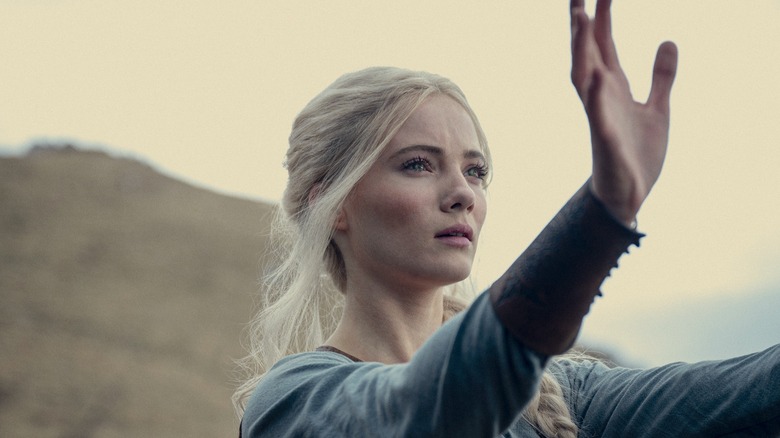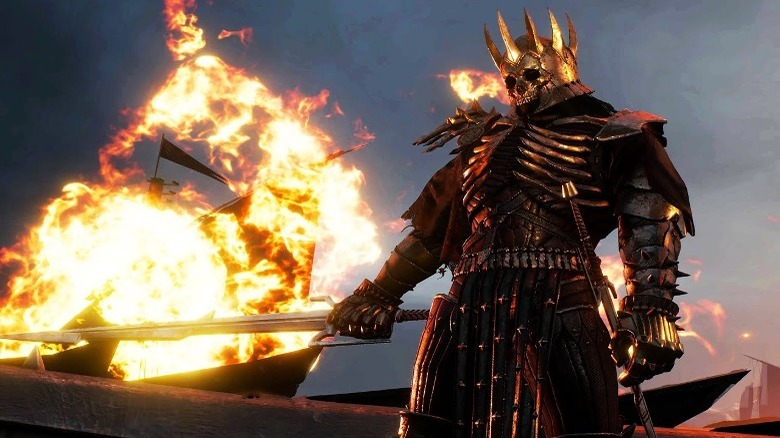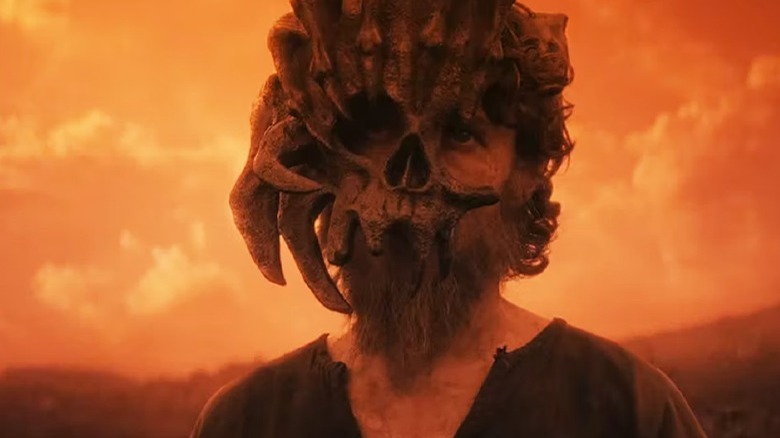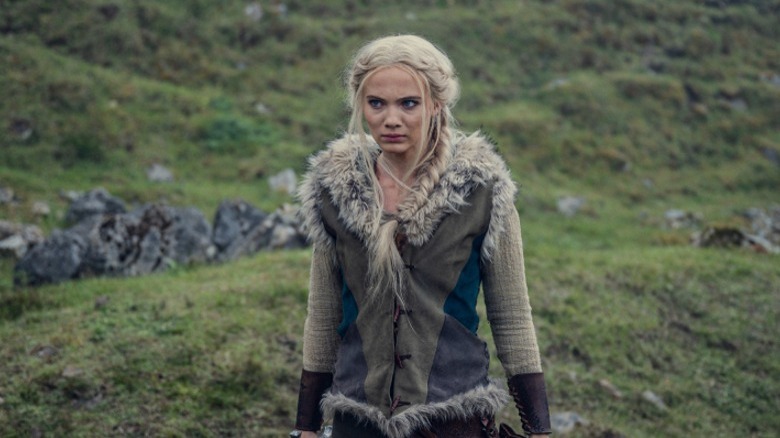The Witcher Season 3 Brings In The Wild Hunt - Here's What You Need To Know
This post contains spoilers for "The Witcher" novel series, games, and Netflix's "Witcherverse."
The Wraiths of Mörhogg. Skeletal, spectral beings who travel across the skies on their undead horses, striking fear into the hearts of men across The Continent. Also known as Dearg Ruadhri and The Wild Hunt, these terrifying entities are considered a portent of doom in Andrzej Sapkowski's "The Witcher" saga, wherein their ominous shadows loom large over the fate of Ciri, who has the Elder Blood. While the Wild Hunt plays a subtler role in the books, both the CD Projekt Red game adaptations and the Netflix series have added their own spin when it comes to this Nazgûl-esque group.
In "The Witcher 3: Wild Hunt," the story shifts to Ciri and her repeated run-ins with the titular group across many worlds, which forges a direct connection to the rapid spread of the White Frost. Although the Wild Hunt is not the only group hounding Ciri for her powers, they certainly emerge as formidable foes, the kind that even Geralt of Rivia refuses to mess with. Both in the video game trilogy and the Netflix series, the arrival of Wild Hunt has been teased as the onset of a great war, accompanied by images of terror where innocent folks are dragged away from their homes in the former, never to return. This makes one thing clear: Ciri's fate will be drastically altered once the Wild Hunt catches up with her.
At the end of "The Witcher" season 2, the Hunt appears in front of Ciri, proclaiming, "Your place is among us. You are ours." This is no empty warning, as season 3 dives deeper into how horrifying the Wild Hunt truly is.
Origins
In Sapkowski's novels, the Wild Hunt is only perceived as spectral, undead beings, as the group magically enhanced their appearance to frighten and intimidate the masses. In reality, they were part of displaced Aen Elle elves who traveled to a different world during the Conjunction of the Spheres, only to exterminate the humans and terrorize the unicorns that inhabited the space. After years of uninterrupted rule, the Aen Elle elves sought out slaves from other worlds, which precipitated the need for a menacing cavalry unit dedicated to raiding different worlds and procuring slaves. Thus, the Wild Hunt was born.
While the Hunt in Sapkowski's novels did use magic to assume more threatening forms, this did not make them any less menacing. Eredin Bréacc Glas, the King of the Wild Hunt, was known to be ruthless and uncompromising in his goals and was especially dedicated to hunting Ciri down. The group's origins and motives are dedicatedly fleshed out in "Wild Hunt," where Eredin and his cavalry covet Ciri after their own world is on the verge of destruction — here, Ciri's Elder Blood is a way to ensure a steady magical bloodline, one that can save the Aen Elle folk from extinction. However, the situation is more complicated than it seems, as the White Frost has now been reforged as a destructive force to submerge the world in snow, which is something Ciri must stop from happening.
In contrast, the Netflix adaptation handles the Hunt in markedly different ways: we are treated to the origins of the group in "The Witcher: Blood Origin," where a young Eredin (Jacob Collins-Levy) is seen trapped in an alternate dimension, slowly withering into the likeness of the skeletal warrior featured in the games. How does this reveal tie into future seasons of "The Witcher?"
Reinventing lore
When it comes to adapting beloved novel sagas like "The Witcher," taking creative liberties to expand or alter an already rich, boundless fantasy world can be a risky undertaking. However, some risks, when rooted in competent storytelling, can deliver worthwhile payoffs. There's a reason why "The Wild Hunt" is so widely praised by die-hard book fans and casual gamers alike — the game delivers on its setup for the antagonists, the Wild Hunt, who emerge as interesting characters that pose a genuine threat to Ciri's very purpose, which she grapples with throughout her journey. The results are chilling and effective, lending much gravity to the final boss fight between Eredin and Geralt.
The first two seasons of "The Witcher" have planted seeds for the eventual appearance of the Wild Hunt, teasing them as portents of doom, but the series is yet to commit fully to unraveling these antagonists. While "Blood Origin" provides an origin story of sorts, the execution feels rushed, as the story juggles too many strands to properly focus on Eredin as an individual or his journey into the feared wraith he eventually becomes. Without delving into spoiler territory, it is safe to say that season 3 intensifies the feeling of doom surrounding the group in relation to Ciri but does little to truly explain why she is indispensable to them.
As the series has taken liberties with regard to character origins so far, it is likely that the Hunt's motivations will be more complicated than a simple case of using Ciri's blood to save their kind. As Voleith Meir had been revealed to be a part of the Hunt itself, the existence of this dimension-hopping Elven group might pose a threat to the Continent itself, without the White Frost even being introduced in this context.
Understanding the Elder Blood status
The Elder Blood gene, also known as the Lara Dorren gene, can potentially grant unimaginable power to the individual bearing it. Ciri happens to be Dorren's descendant, and the only person known to possess the gene's activated powers, which often skips entire generations by remaining dormant. As the circumstances surrounding Ciri's birth were unique, and Geralt's presence led to her being invoked by the Law of Surprise, these events wove inescapable threads of destiny that bound Ciri to Geralt, explaining their irrevocable familial bond.
In the Netflix series, various groups covet Ciri (Freya Allan) for her abilities: the Elves believe that she is the key to their freedom, the conclave of Mages deem her as a threat, while Emperor Emhyr (Bart Edwards) has his own schemes to have Ciri by his side as the Princess of the Nilfgaardian Empire. As the Wild Hunt's proclamations for Ciri have been rather ominous so far, it is fair to assume that their goal is to use her as a means to unleash chaos. As Eredin used to be loyal to the Golden Empire, it is possible that the Hunt intends to remake the world in the image of a brutal, violent past, where the Elder Blood status acts as a catalyst for a new era.
It will be interesting if "The Witcher" introduces familiar characters such as Caranthir or Imlerith to deepen our understanding of the Wild Hunt in Volume 2 of the latest season, which is gearing towards a finale with catastrophic repercussions for everyone involved. Will the Wild Hunt appear and unleash their undead hounds into the world? If that happens, it will take more than one white-haired witcher to save the day.
Volume 1 of "The Witcher" season 3 is currently streaming on Netflix.



